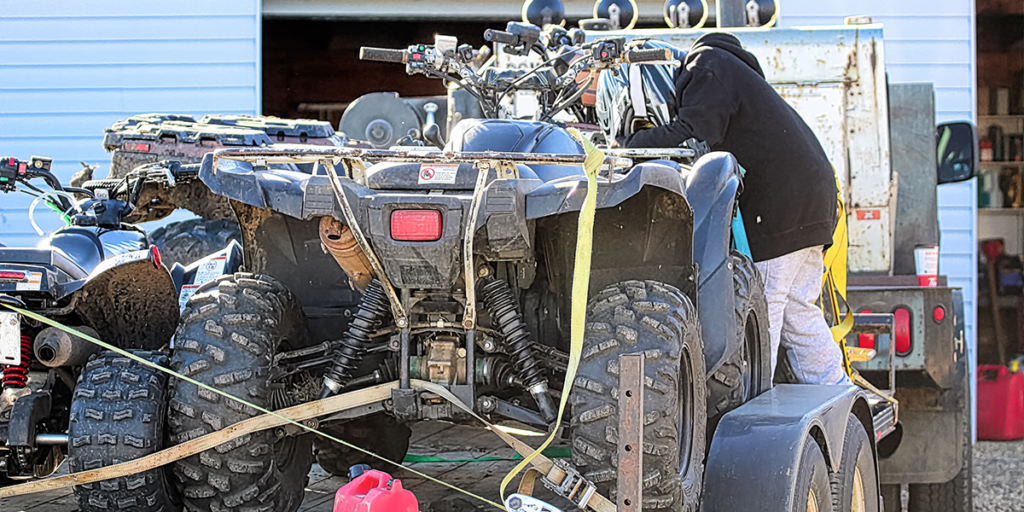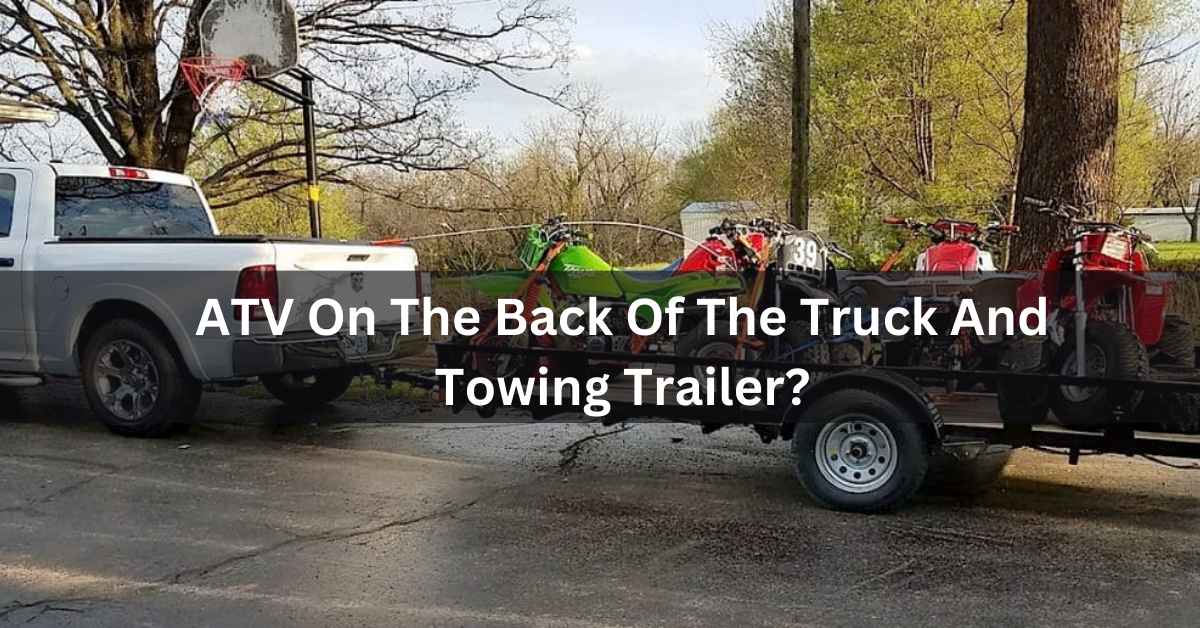Are you an adventure admirer with an ATV (All-Terrain Vehicle) looking to explore new trails? You’ve probably wondered how to safely and conveniently transport your ATV.
Towing an ATV on the back of a truck or a trailer involves a combination of proper equipment, secure loading techniques, and safe driving practices.
This comprehensive guide will delve into the complications of towing an ATV, providing practical tips and expert advice to ensure a safe and smooth journey. Stay with us till the end!
Key Steps For a Safe ATV Journey Using A Truck And Towing A Trailer – Let’s Explore!
1. Select the Appropriate Trailer:
Your priority is ensuring the trailer you opt for is well-suited to accommodate your ATV. Verify its strength and capacity for the intended load and ensure it boasts suitable tie-down points.

2. Safely Fasten the ATV onto the Trailer:
Utilize high-quality tie-down straps to firmly secure the ATV onto the trailer. It’s essential to position the ATV securely and align it centrally on the trailer to evenly distribute its weight.
3. Maintain Proper Weight Distribution:
Proper weight distribution is pivotal for safe towing. Confirm that the ATV’s and trailer’s weights remain within the truck’s towing capacity. Also, discover that the tongue weight, or the weight applied to the hitch ball, remains within the order range.

4. Verify the Trailer Hitch:
Make certain that the truck is equipped with a suitable trailer hitch capable of handling the collective weight of the ATV and the trailer. Always adhere closely to the manufacturer’s installation and usage instructions.
5. Implement Safety Chains:
Safety chains are most important. These chains function as an additional safety layer by connecting the trailer to the truck, reducing risks should the trailer be removed from the hitch.
6. Inspect Brake and Light Functions:
Thoroughly inspect the operational state of the trailer’s brake lights, turn signals, and other necessary lights. This carefulness ensures other drivers can expert your intentions, thus decreasing the likelihood of accidents.

7. Exercise Caution While Driving:
Acknowledging that towing a trailer will impact your truck’s handling and braking is imperative. Approach driving with a heightened awareness: Increase your braking distance and be prepared to navigate wider turns to account for the trailer’s extended length.
8. Mindful Speed and Distance Maintenance:
Maintaining a reasonable, safe speed while towing. Additionally, leave more space between your truck and other vehicles to accommodate the need for longer braking times and heightened reaction intervals.
9. Monitor Tire Pressure:
Be attentive to maintaining proper tire pressure for your truck and the trailer, including the spare tire. Neglecting this detail could lead to compromised handling and reduced fuel efficiency.
10. Frequent Checkpoints:
Strategically plan regular stops during your journey to inspect the integrity of the ATV’s tie-downs and the overall condition of the trailer. This step gains paramount importance during lengthy trips.
By following these detailed steps, you can safely and effectively load your ATV onto the truck bed, minimizing the risk of damage to your vehicle and ensuring a smooth transport experience.
Some Considerations Before Installing ATV To The Truck Or Trailer – Take a Look Here!
When it comes to ensuring the safety and protection of your all-terrain vehicle (ATV), it’s crucial to consider every aspect, including transportation.
Before you embark on a journey that involves transporting your ATV, it’s wise to take a moment to understand the implications of your insurance coverage.

Your standard ATV insurance policy may cover various scenarios, such as accidents, damage, theft, and liability while riding your ATV.
However, the extent of this coverage might only sometimes extend to transportation situations.
Detailed Breakdown Of The Maintenance Tips – You Should Follow!
1. Scheduled Inspections:
Create a routine inspection schedule for your truck, trailer, and ATV. Regularly set aside time to thoroughly assess the condition of each component. Aim for at least a monthly check-up, and increase the frequency if you use your vehicles extensively.
2. Exterior Examination:
Start with a visual inspection of the exterior. Look for any signs of rust, dents, scratches, or other visible damage. It includes checking the body, frame, and accessories like mirrors, lights, and windows. Attend to any cosmetic issues promptly to prevent them from worsening.
3. Bolster Your Ride with Essential Tire Care:
Pay close attention to tire condition. Check the tire pressure, tread depth, and overall wear. Underinflated or balding tires can affect handling, fuel efficiency, and safety.
4. Check The Fluid Levels:
Regularly inspect fluid levels, including engine oil, coolant, brake fluid, transmission fluid, and power steering fluid. Ensure that each fluid is at the appropriate level and clean. Dirty or low fluids can lead to engine damage and decreased performance.
5. Focus On The Brake System Of ATV:
Properly functioning brakes are paramount for safety. Inspect brake pads, rotors, and brake lines. Look for signs of wear, such as squeaking or reduced responsiveness. Address any brake-related issues immediately.

6. Upgrade Your Electrical System:
Check all electrical components, including lights, indicators, and gauges. Ensure they are functioning correctly. Faulty electrical systems can lead to visibility issues and safety hazards.
7. Engine Performance:
Monitor engine performance and listen for unusual noises. Address any engine-related problems promptly, as they can lead to decreased fuel efficiency and potential breakdowns.
By sticking to these maintenance tips and promptly addressing any issues, you’ll enhance the safety and reliability of your truck, trailer, and ATV and extend their lifespan.
Frequently Asked Questions:
1. How can my truck safely tow an ATV and a trailer?
Ensure your truck’s towing capacity exceeds the combined weight of the loaded ATV and trailer. Consult your truck’s manual or contact the manufacturer for precise towing limits.
2. Can We tow two ATVs on a single trailer?
Yes, but make sure the trailer is designed and rated to handle the weight of two ATVs. Follow proper loading and securing techniques for both ATVs.
3. Should I cover my ATV while towing?
Covering your ATV to protect it from road debris and harsh weather conditions is a good idea. Use a secure and weather-resistant cover.
4. Are there any legal regulations I need to consider while towing?
Absolutely. Check your local and state rules regarding towing trailers and ATVs. Ensure your trailer has proper lighting and adheres to road safety standards.
5. What’s the ideal speed for towing a trailer with an ATV?
Stay within the recommended speed limits and drive at a common pace. Avoid high speeds, sudden action, and harsh braking to maintain stability.
6. Can I reverse with an ATV on the back of the truck?
Changing with an ATV on the truck requires caution and practice. Have a spotter guide you, and take it slow to avoid collisions or damage.
Final Thought:
In a conclusion of ATV On The Back Of The Truck And Towing Trailer, I would say;
Safely transporting your ATV on a truck or trailer demands attention to detail and adherence to crucial steps. Proper trailer selection, secure loading, weight distribution, and cautious driving are paramount. Regular maintenance ensures reliability.
Following the steps outlined in this guide, you can confidently transport your ATV to your desired destination and embark on memorable outdoor adventures.
